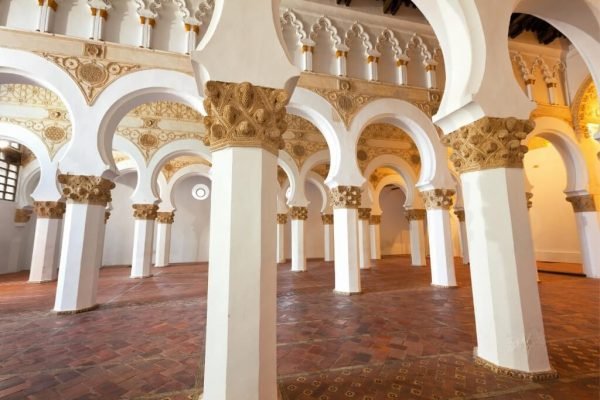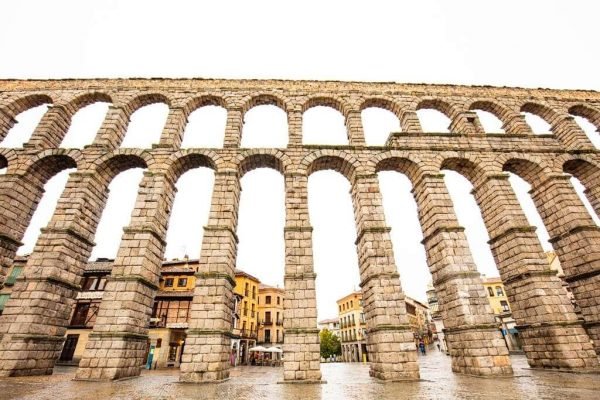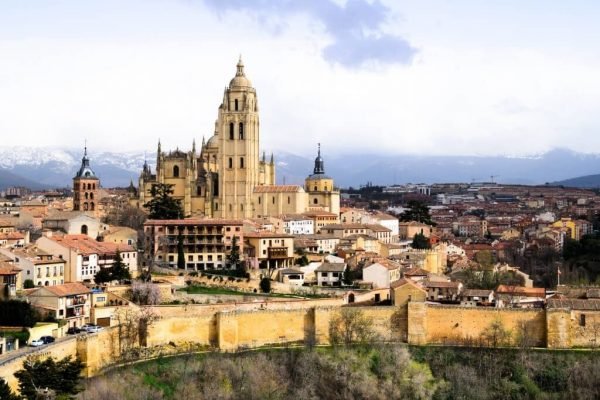Day trip to Toledo and Segovia
PEPE TOURS
Day trip to Toledo and Segovia
PEPE TOURS
Description: Day trip to Toledo and Segovia
Full-day excursion from Madrid to visit Toledo and Segovia, two monumental cities, World Heritage Sites. Very close to Madrid lies the Imperial City of Toledo, the famous city of the three cultures, its streets were synonymous with coexistence between Jews, Moors and Christians and its historic centre preserves the layout it had in the Middle Ages. To the north of Madrid, just over an hour away, located on a hill between the Eresma and Clamores rivers, Segovia awaits us, where its famous Aqueduct, multitude of Romanesque churches, Cathedral and Alcázar – Castle make up a majestic landscape that dominates these Castilian lands.
Tour accompanied by official tourist guides who will explain the city’s history, monuments, characteristics and customs, driven in modern, air-conditioned coaches. Departure from our terminal to Toledo, a museum city of great artistic beauty, which was the capital of the country and one of the oldest cities in Europe. Upon arrival, we take a panoramic tour by bus to enjoy the magnificent view of the city from the other side of the Tagus River, a must-see stop to take the most popular photo of Toledo. Next, we’ll visit a damascening workshop, where we’ll observe this traditional Toledo craft technique. Then, accompanied by a local expert guide, we’ll take a walking tour through Toledo’s historic centre to get a first impression of this imposing medieval city and take note of its most iconic landmarks. This introduction will help you explore further on your own later.
We’ll visit Plaza Zocodover, the city’s most emblematic square, surrounded by buildings in styles ranging from Renaissance to Baroque. We’ll then pass by the Alcazar of Toledo, a majestic fortress that today houses the Army Museum. Wandering through Toledo’s narrow streets, we’ll arrive at Plaza del Ayuntamiento (Townhall Square), where we’ll admire the façade of Toledo Cathedral, officially known as the Primate Cathedral of Spain. It is a stunning structure blending Gothic, Renaissance, and Baroque styles, built atop the foundations of an ancient mosque.
After the tour, you’ll have free time to enjoy lunch and shop for souvenirs on the famous Calle Comercio, a pedestrian street full of shops, restaurants, and bars. Here, you can find a wide array of local products, from traditional sweets to Toledo crafts like swords and damascened metalwork.
At the indicated time, we board the coach to return to Madrid, and from there, continue on to Segovia – a dreamlike city with unique architecture. Chosen by some of the Kings of Castile as their residence, Segovia preserves one of the most remarkable medieval ensembles in Spain.
Upon arrival, we’ll begin a guided walking tour of Segovia from the iconic Roman Aqueduct, a masterpiece of ancient engineering, to the heart of the historic centre. We’ll stroll along charming medieval streets and admire several notable landmarks from the outside. Among them is the Casa de los Picos, one of Segovia’s most famous buildings, with a façade covered in more than 600 diamond-shaped granite blocks that give it its distinctive look.
We continue to the Plaza de Medina del Campo, where we find the Church of San Martín, a beautiful Romanesque temple, along with several Renaissance palaces like the Casa de los Solier and Casa de Bornos, reflecting the importance of this plaza in past centuries.
Our next stop is Plaza Mayor, the city’s vibrant heart, surrounded by architecturally significant buildings, traditional shops, cafés, and restaurants. The most prominent structure here is the Cathedral of Segovia, the last Gothic cathedral built in Spain and considered by many the Lady of Spanish Cathedrals for its elegance.
We’ll end our walk at the gates of the Alcazar of Segovia, one of the most spectacular castles in the country (entrance not included) – a fairy-tale fortress with pointed towers and breathtaking views. You’ll also have the optional opportunity to visit the Cathedral’s interior to further enrich your experience.
After a day filled with history and beauty, we return to Madrid, bringing with us unforgettable memories of two remarkable cities.
Departure days:
Friday, Monday, Saturday, Sunday, Thursday, Tuesday, Wednesday
Servicios incluidos:
– Travel insurance
– Bus transportation from Madrid to Toledo and Segovia with an official guide
– Panoramic tour by bus
– Guided walking tour of the old town of Toledo and Segovia
– Entrance to the Segovia Cathedral
– Accompanying guide throughout the trip
– Entrance and visit to the Primate Cathedral of Toledo (only option with cathedral)
Price details:
| PRICES PER PERSON IN EUROS (SEASON 2025 - 2026) | |
| ADULT | from 69 € |
| CHILD (3 – 11 years) | from 65 € |
Information of interest:
Toledo
Toledo, a World Heritage City, is 70 km from Madrid. It is a city-museum of great artistic beauty and one of the oldest in Europe. It is known as the “City of the Three Cultures” because Christians, Muslims and Jews lived here. Its buildings cover practically all periods of history (Arab, Gothic, Mudejar, Renaissance and Baroque). El Greco, a great painter of the 16th century, lived here. In 2014, the fourth centenary of his death was celebrated.
The Imperial City of Toledo, recognized by UNESCO as a World Heritage Site in 1986, is located just 60 kilometres from the capital, Madrid. Of the three cultures that coexisted within its walls – Arab, Jewish and Christian – there are still some historical vestiges today, such as the Primate Cathedral, the Mosque of Cristo de la Luz, the Synagogue of El Transito, the Alcázar and the celebration of Corpus Christi, one of the most important and popular processions in Spain.
The various peoples who have passed through Toledo have successively left their mark on the city. For example, the walls, which have existed since Roman times, were rebuilt and received their current layout under the Arabs. There are many gates along them, but the Puerta de la Bisagra, which has the coat of arms of the Imperial City on its top, is the most representative and the one that gives access to the historic city.
Mosque of Cristo de la Luz (10th century). The only one of its style that survives of the ten that existed in the city. It is located just after the Puerta de la Bisagra. The horseshoe arches follow one another in a space that recalls and is based on the mosque of Córdoba.
Synagogue of El Tránsito (14th century). Beautiful plastered walls precede a rectangular interior, covered by a beautiful alfarje (flat frame). It houses the Sephardic Museum.
Primate Cathedral. Gothic in style. It was built between 1226 and 1493 on the site of a Visigothic church built during the reign of Recaredo. The sacristy houses a valuable collection of paintings by El Greco, Lucas Jordán, Van Dick and Goya. But all the rooms are works of art: from the Chapel of the New Kings to the Chapel of Santiago, including the Renaissance choir, the Mozarabic chapel and the chapter house.
El Greco House Museum. Although a plaque at the entrance indicates that the painter did not live here, it does house some significant paintings by the Cretan artist, such as The Tears of Saint Peter or The Apostolate.
Alcázar of Toledo. Located in the highest part of the city, it was a palace in Roman times and under the Christians it became the first square-shaped fortress. Under Charles I it underwent a major remodelling. Each façade is of a different style and period: the east is medieval, the west is Renaissance, the north is Plateresque and the south is Churrigueresque. It was destroyed by the invasion of French troops and the Spanish Civil War, but after its reconstruction it houses the Army Museum and military facilities.
A time and a history that are linked to craftsmanship: Toledo swords, ceramics and damascening. The manufacture of swords and sabres is mainly intended for tourism, although there are orders from some armies around the world. As for damascening, it is an Arab decorative practice that consisted of inlaying gold or silver on less noble but harder materials (iron, bronze, steel, earthenware, porcelain…) and is used in rings, bracelets, brooches, plates. All the streets are full of workshops and shops dedicated to crafts that do not go unnoticed by the visitor and turn some spaces into small bazaars.
Segovia
Declared a World Heritage Site in 1985, Segovia is world-famous for its impressive Roman aqueduct. But tourists can also see other historical monuments in this Castilian-Leonese city, such as the Gothic cathedral, the Alcázar, the Tower of San Esteban, the Parral Monastery, the Corpus Christi Synagogue, as well as a large number of small Romanesque style churches.
The Aqueduct. This is one of the most spectacular legacies left by the Roman Empire in Spain. In total, 166 arches form the more than 17 kilometres of the aqueduct that transported water from La Acebeda to the Alcázar, defying gravity, as only the balance of forces keeps this construction standing, which does not require any type of mortar. Legend has it that the aqueduct was built by the devil in just one night to obtain the soul of a young woman who had tempted him in this way: “I will offer you my soul if you bring the water to my house before the rooster crows.”
The Cathedral. The apse of this temple, whose construction began in 1525, frames the Plaza Mayor and marks the border with the Old Jewish Quarter. Inside, the 16th-century stained-glass windows and the Main Altarpiece designed by Sabatini stand out.
The Alcázar. The splendid views of the Pinarillo (with the Jewish cemetery), Zamarramala and the church of Vera Cruz are reason enough to visit this ancient fortress, which has been the residence of kings since the 13th century. A deep moat with a drawbridge opens onto this fortress, from whose turret Alfonso X studied the sky. To his left is the Casa de la Química, built in the Age of Enlightenment and Louis Proust’s research centre.
Please note that
Exceptionally, the itinerary and the order of the excursions could be altered and modified for organizational reasons.











